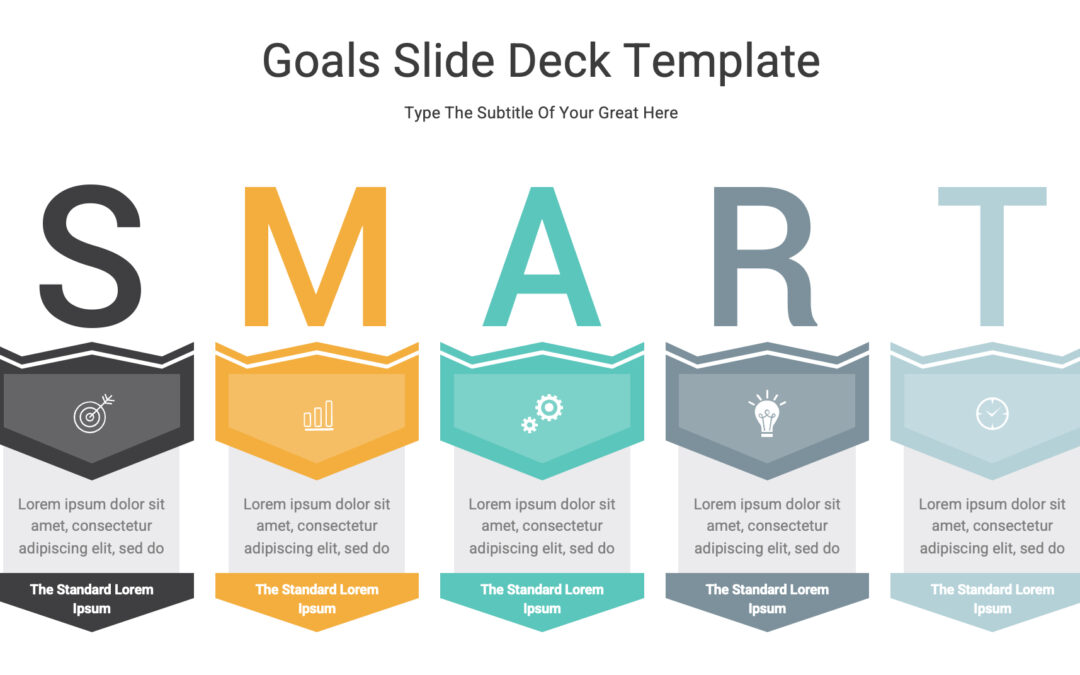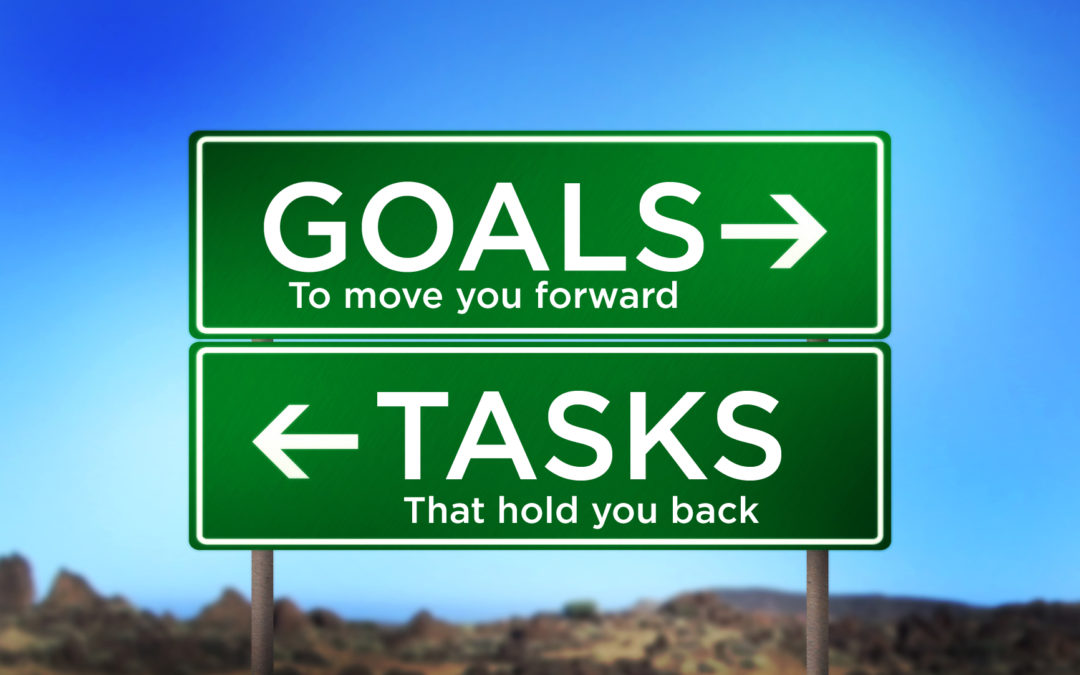
All Posts, Business Strategy, Work Life
This is a touchy topic for me, and I want to be transparent about that right out of the gate. I’m one of those people that love checklists, task lists, agendas, timelines, and even time-boxing. But when I am starring at multiple project management apps, multiple lists, and multiple deliverables, it can be debilitating.
Setting realistic yet challenging goals is key to achieving success as a small business owner. By setting goals that are attainable, you can stay motivated and focused, but by making sure they are also challenging, you can push yourself to grow and improve.
Have You Heard About the SMART Framework?
A good way to set goals is by using the this structure of Specific, Measurable, Achievable, Relevant, Time-bound. I won’t get into each of them too much but the shortcut of all of those is to consider each part of that framework when you are creating or defining out your goals. If they don’t have each of these elements then chances are you won’t actually achieve completion. Remember, the “goal” of this is to be in or better align with your overall business objectives.
Keep your focus on the most important thing at the start of your day, which is to take action and make progress towards your goals, no matter how small. I can’t tell you how many times I’ve felt stuck or overwhelmed with so many things I want to get done or accomplish, but then shifting to low hanging fruit, or things that will give me a sense of completion really help boost motivation to go and tackle bigger things. We’ve all heard of “Eat That Frog” and sometimes doing that first makes the rest of what you need to do seem like easy downhill coasting. Every step you take, no matter how small, is a step in the right direction. And don’t forget to celebrate your successes along the way!
One last idea, put your goals out there in public. Peer motivation can also be a great motivator. Again follow the S.M.A.R.T. framework, and see how much more accountable you will feel and encouraged to digging into your goals and making consistent progress each day.
Download a free Goal Slide Deck Template: http://dthero.co/goalslidedeck

Blab Video Replays, Blog, Photography
Last week I was asked to get on to a talk about goals. The host of the show was Abdul, and he came up with the idea and talking points to go over. It’s a good honest talk and we all talk about some good ways to make and keep goals as well as making yourself accountable to those goals.
All Posts, Content & Copywriting
 While talking to a client about her new website that Design Theory is currently creating, we began discussing and distinguishing the differences of websites similar to her industry. During the discussion I asked her if she wanted a Pop Tart vs. Toaster Strudel design and content. We both chuckled while I explained the difference and how that would affect her readership and visitation numbers. As I explained my breakfast treat comparison, it occurred to me that this would make great content itself for a blog. So with sweet treat comparatives, tongs in hand, let’s see what the difference is and what to look out for when designing your own personal use or business website.
While talking to a client about her new website that Design Theory is currently creating, we began discussing and distinguishing the differences of websites similar to her industry. During the discussion I asked her if she wanted a Pop Tart vs. Toaster Strudel design and content. We both chuckled while I explained the difference and how that would affect her readership and visitation numbers. As I explained my breakfast treat comparison, it occurred to me that this would make great content itself for a blog. So with sweet treat comparatives, tongs in hand, let’s see what the difference is and what to look out for when designing your own personal use or business website.
Sticky Jelly or Oozing Content
Pop Tarts Toaster Strudel
Can be stored at room temperature Must stay frozen until ready for consumption
No need for refrigeration Leaving it out over 12 hours may make it unfit for consumption
What does this say about the quality of your content & about your website? Quickly written, often plagiarized content will only be worth the effort put into it. However content that is fresh, witty and deliberate will evoke the proper response for the goal set before it. It will be more pleasing and can easily be distinguished. And that’s exactly what you want and need to get your product and/or services sold. Once again, it’s a distinction between what looks good and achieves the goal that should direct the content accordingly.
Static or Creative Icing
Is your content very cookie-cutter, stationary or could be considered stale? Or does the verbiage move, flow and swirl to create interest and hold your reader’s attention? Is your use of imagery typical or often used stock photography or is it distinctive and has an artistic, creative flare to it? When choosing imagery, keep in mind that it should enhance and not compete with your written content to give a cohesive and an overall polished look to your website. You can have fun and go outside the box with most industries. Even content that is more factual and less opinionated can be creatively distinct while getting your message across and conveying important information.
Sometimes Pricing Makes a Difference, Sometimes Not
Pop Tarts Toaster Strudel
$3.99 for a 8 piece box $3 for a 6 pastry box
Being in the middle of the pricing spectrum for websites, we at Design Theory have had to burst the bubble of misconceptions when it comes to our prices versus the quality of talent/work we do. Our goal is to match the goals and level of business of a client’s company with a website that will do just that within the confines of their allotted budget. Now sometimes we have to push back and encourage a particular client to go beyond their budget and give them some industry inside look as to why. And because we do what we do well, it’s usually not hard for them to acknowledge the benefits of doing so and agree. But for other companies, just be aware that all that glitters may not be gold and likewise, the cheapest design/pricing may not be tarnished brass. Remember, there’s a difference between cheap and affordable web designs. I believe you have to ask the right questions, look at a company’s track record/dossier and determine what’s best for your business. Then you can make an educated decision about how much you NEED to pay for a website that fulfills its purpose for your business or personal objectives.
So depending on what your business palate wants and needs, you can determine whether you choose a “mediocre but gets the job done” website & content, or if you’re in need of a step-up, more sophisticated level design. Whichever works for you, make sure you choose well and always consider the palate of your consumers.
~ Content Writing Inspiration ~ 
True Ease in Writing comes from Art, not Chance,
As those move easiest who have learn’d to dance.
~Alexander Pope, “An Essay on Criticism”
All Posts, Web Design
 As a designer, either in graphics, coding, programming, or in web, we tend to get totally involved in our projects. A lot of times we juggle more than two projects at a time without our clients even knowing, but still providing full support and service. Over time we get used to this type of multi-tasking without even thinking about it, scheduling time to plug in updates, billing, and more. Now what about projects and to our own websites? When will we have time to post new blogs? Update images and links? Yea, this is one of those things I can say (generally speaking) that we all put of way too much.
As a designer, either in graphics, coding, programming, or in web, we tend to get totally involved in our projects. A lot of times we juggle more than two projects at a time without our clients even knowing, but still providing full support and service. Over time we get used to this type of multi-tasking without even thinking about it, scheduling time to plug in updates, billing, and more. Now what about projects and to our own websites? When will we have time to post new blogs? Update images and links? Yea, this is one of those things I can say (generally speaking) that we all put of way too much.
Between client emails, conference calls, meetings, and the occasional work here and there, it’s hard to find the time to actually do work on our own projects. That includes updating those little annoyances about our work that people may have caught and we still haven’t had time to fix. You also have to consider time to learn new apps and technologies pertaining to your trade.
I’ve learned that time management is such a necessity but is often overlooked. Most of us pretty much go about our days with a general idea of what tasks we will accomplish. Whatever is most important and approaching a deadline, we put to the top of our list of things to do, and the rest is a bonus or shelved for a later date. However there are days where this could totally bite us in the rear for lack of planning. I’ve come up with 5 quick and easy ways to find ways to get to our own projects while keeping in step with our client ones.
1) Populate your calendar down to the hour. This may seem like a big task, but once you get it started and up to date, filling in your tasks and projects by the day and hour will really help you find open times.
2) Create a To-Do List. There are many books out there on Getting Things Done (GTD), and all will recommend a list of some sorts with all of your tasks. Since we’re so tech savvy, there are also smartphone apps and web sources to help with this also. Toodledo is a great free one to get you started.
3) Set Realistic Goals. If you know you need to make some serious adjustments to your own site or work, set a goal for when you want to complete it. Not just a mental one, but actually write it down and place it somewhere that you’ll be constantly reminded of it. Be sure to make these goals tangible. After completing a few you’ll feel proud and accomplished.
4) Eliminate the fluff. The constant checking in on your social sites, spam email accounts, watering the plants, watching sunsets, calling to check on mom. You know what I mean. These fillers are nice “fluff” but take away from what you really need to get done. Though it may be important
5) Make yourself accountable. Now this may be the toughest off all, but I promise it works. Being a freelancer, you really are only accountable for your deliverables to yourself and your client. As an employee, your tasks need to get done so that the next person in line can do theirs. So appoint a fellow designer, friend, or significant other to monitor your projects. Maybe start with the big ones at first so you don’t start resenting them with the smaller tasks and projects.
If you’ve come up with ways other than what I’ve described please let us know in the comments below. It’s all about helping others improve, and we all know we can use improvements every now and again.













